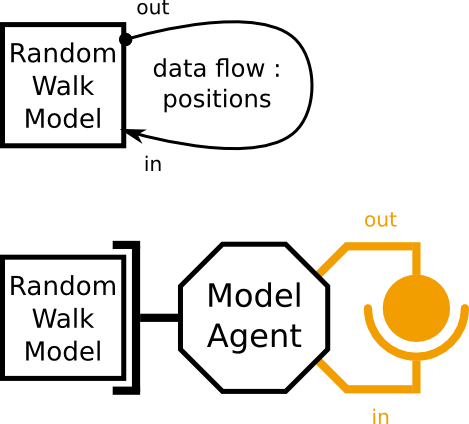In this tutorial, we present the implementation of the coupling-artefact (which role is to allow the model-agent to exchange some data and take operations on the data flow).


/**
* This class represent one part (IN port) of the coupling artefact that allows
* the agent to read data from it. In this implementation the coupling-artefact
* is in charge of the agents positions.
*
* @author Julien Siebert
* @since Darjeeling
*/
public class IPCA_WalkerPositions extends InputPort<TurtlePositions> implements
JmsPort {
// jms parameters
private String topicName;
private String connectionFactoryName;
// end of jms parameters
/**
* COnstructor
*/
public IPCA_WalkerPositions(Class<TurtlePositions> ObjectClassToSendToJms,
String NameOfInputPortToJms) {
super(ObjectClassToSendToJms, NameOfInputPortToJms);
setJMSConnexionParameters();
init();
}
public void init() {
try {
jmsInputBinding.init(topicName, connectionFactoryName);
} catch (NamingException e) {
e.printStackTrace();
} catch (JMSException e) {
e.printStackTrace();
}
}
public void setJMSConnexionParameters() {
topicName = "shared_data";
connectionFactoryName = "shared_data_topic_connection_factory";
}
}/**
* This class represent one part (OUT port) of the coupling artefact that allows
* the agent to read data from it. In this implementation the coupling-artefact
* is in charge of the agents positions.
*
* @author Julien Siebert
* @since Darjeeling
*/
public class OPCA_WalkerPositions extends OutputPort<TurtlePositions> implements
JmsPort {
// jms parameters
private String topicName;
private String connectionFactoryName;
// end of jms parameters
/**
* Constructor
*/
public OPCA_WalkerPositions(Class<TurtlePositions> ObjectClassToReadFromJms,
String NameOfOutputPortFromJms) {
super(ObjectClassToReadFromJms, NameOfOutputPortFromJms);
setJMSConnexionParameters();
init();
}
public void init() {
try {
jmsOutputBinding.init(topicName, connectionFactoryName);
} catch (NamingException e) {
e.printStackTrace();
} catch (JMSException e) {
e.printStackTrace();
}
}
public void setJMSConnexionParameters() {
topicName = "shared_data";
connectionFactoryName = "shared_data_topic_connection_factory";
}
}